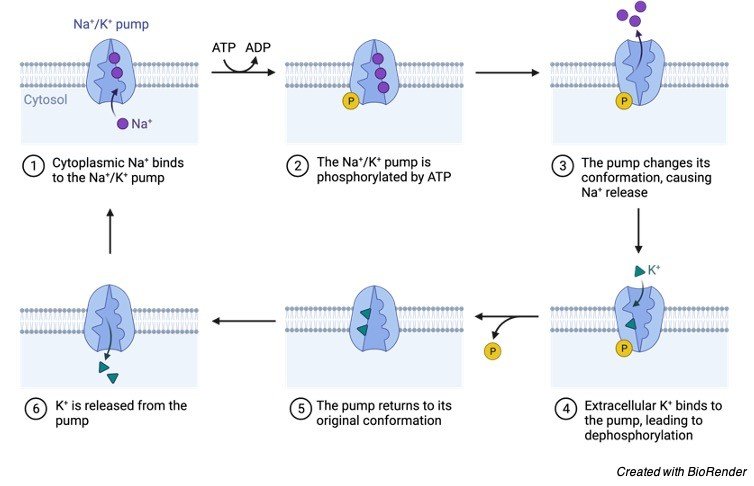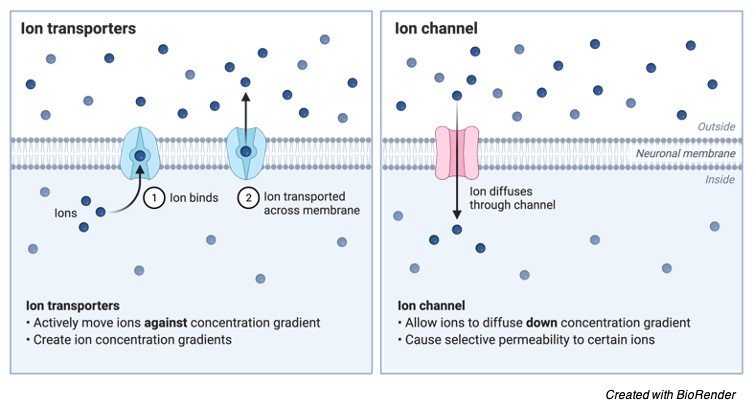Table of Contents
Carrier Protein Definition
A carrier protein is a type of protein in biology that transports a specific item across intracellular compartments, into the extracellular fluid, or between cells, as opposed to channel proteins, which are another form of membrane transport protein that transports molecules less selectively. Carrier proteins, like other membrane transport proteins, are present in lipid bilayer cell structures such as cell membranes, mitochondria, and chloroplasts.
What is Carrier Protein?
Carrier protein is a type of cell membrane protein that helps things leave or enter the cell by facilitating diffusion and active transport. Carrier proteins are in charge of sugar, amino acid, and nucleoside transport. They are also the proteins that pick-up glucose molecules and transport them, as well as other molecules (such as salts, amino acids, and other nutrients), throughout the cell.

For example, carrier proteins embedded in the cell membrane, such as integral transmembrane proteins, would have a high affinity for certain chemicals on the cell exterior and then undergo a conformational shift to allow these substances to flow through the membrane barriers into the cell interior.
Carrier Protein vs Channel-Formers
Carrier proteins, like channel proteins, are membrane transport proteins. Membrane transport proteins are proteins that move molecules from one site to another in biological membranes. However, there are some differences between these transporters. As the name indicates, channel proteins produce a “channel” that allows molecules to flow through. Their hydrophobic regions interface with the membrane’s lipids and keep them securely embedded in the plasma membrane.
Pores are channels that stay open to both the inside and exterior of the cell. Aquaporin is an example of a channel protein that permits water molecules to pass across the cell membrane. Carrier proteins, on the other hand, do not create channels. Rather, they have binding sites where molecules can attach themselves. The molecules are then shuttled to their final destination, which is either the inside or exterior of the membrane.
Carrier proteins with binding sites are more discriminating when it comes to the chemicals they carry. Furthermore, they are not open to both the inside and outside of the cell at the same time, unlike certain channel proteins, such as porins, which are open on both sides at the same time. As a result, unlike porin channels, carrier proteins may actively transport molecules across a concentration gradient.
Types of Carrier Protein
Carrier proteins engaged in the active transport of molecules or substances can be categorised according to the type of transport activity they perform. Carrier proteins that are accelerated by a concentration gradient rather than ATP hydrolysis are known as carrier-mediated diffusion proteins. They move molecules from a high-concentration location to a low-concentration area. Sugars, amino acids, and nucleosides, for example, are transported across the majority of cell membranes by carrier proteins.
Carrier proteins that carry molecules across a concentration gradient consume a lot of energy. The carrier proteins can be categorised as (1) ATP-driven, (2) electrochemical potential-driven, or (3) light-driven, depending on the energy source. ATP-driven carrier proteins transport molecules utilizing ATP, whereas electrochemical potential-driven proteins transport molecules using electrochemical potential. Pumps that are powered by photons are known as light-driven pumps. In bacterial cells, these pumps are widely encountered.
ATP-driven Carrier Proteins
Carrier proteins that require ATP coupling to transport molecules are known as ATP-driven. An ATP-driven carrier is the sodium-potassium pump in the plasma membrane of animal cells. The sodium and potassium ions are selectively bound by the pump. This pump maintains adequate amounts of such ions in order to preserve homeostasis. For each ATP molecule it consumes, the pump actively transfers three sodium ions (Na+) from the interior of the cell and replaces them with two potassium ions (K+) from the outside. Primary active transport is a form of active transport in which the process is powered by chemical energy (ATP).

Electrochemical potential-driven carrier proteins are those whose transport activity is fuelled by an electrochemical potential gradient. Secondary active transportation is the name given to this type of active transportation. Because two molecules are carried through a membrane at the same time, it is also known as linked transport.
A symporter is a carrier protein that transports two molecules in the same direction. An antiporter is a carrier protein that transports two molecules in opposing directions. Nonetheless, certain porters are capable of transporting a single molecule from one side to the other of the membrane. Uniporters are what they’re called. Look for the figure illustrating the three types of carrier-mediated transport in this material to get schematic depictions of the three types of porters.
Function of Carrier Protein
Carrier proteins are engaged in biological transport mechanisms that are both passive and active. Molecules are moved downhill via passive transport, from a higher to a lower concentration. A concentration gradient is created by the difference in concentrations between two areas, which is sufficient to initiate passive transport. However, due to the cell membrane’s lipid bilayer structure, not all molecules will be able to flow out or into the cell in accordance with their concentration gradient.
Polar molecules and ions are unable to pass across the membrane easily. Membrane transport proteins, similar to carriers, are required to assist their movement. If a carrier protein is used in the process, the molecule “sits” on the carrier protein on one side of the membrane before being transported to the other side and released. Facilitated diffusion is a type of diffusion (or passive transport) that uses a membrane protein to move molecules along a concentration gradient.
While certain membrane proteins are unable to participate in active transport, carrier proteins do. Molecules attached to carrier proteins have the ability to migrate upwards, from a lower concentration location to a higher concentration area. Active transport occurs when molecules travel against the concentration gradient, i.e., in the opposite direction of where they would normally go, since the region is already concentrated. As a result, an energy source (such as ATP) is required to power the process. This is what happens when Na+ and K+, as well as NADH, are actively transported through the inner mitochondrial membrane, where ATP is linked to their transport.
Transport Mechanism
The carrier proteins in both passive and active transport move molecules by attaching to them and then changing their conformation. As they transport molecules from one side of the membrane to the other, they alter their form. However, chemical energy is necessary for active transport. When ATPases catalyse the breakdown of ATP to ADP, energy is released by ATP hydrolysis.
The release of one inorganic phosphate from ATP results in the simultaneous release of energy. Direct ATP coupling does not power all active transport activities. Instead of ATP, an electrochemical gradient is used in another kind of active transport. Cations travelling passively, for example, produce entropy that can be used to power the active transport of another set of ions.
Carrier Proteins Examples
1. Glucose Transporters
When the cell contains less glucose than the outside, “glucose transporters” in the cell membrane of animal cells take up glucose molecules without using ATP. Glucose is an important biomolecule since it provides a source of energy. There are 14 glucose transporters in human cells. They are uniporters, meaning they only bind to and transport glucose molecules. GLUT1 is a glucose transporter that is found in virtually all cell types. It is most highly expressed in red blood cells in adults.
ii. Sodium-Potassium Pump (Na+/K+ Pump)
An antiporter is the Na+/K+ pump. It has Na+ and K+ ion binding sites. The pump requires an energy source since the flow of these ions is against their concentration gradients. As a result, it attaches to ATP and hydrolyses it into ADP, releasing energy. This energy is used by the pump to change its form. The ions dissolve from the pump after conformational change, but they are released in opposing directions. Na+ ions are pushed out of the cell, whereas K+ ions are pumped in. The function of the Na+/K+ pump is critical because it is involved in nerve impulse transmission and cell membrane potential maintenance. The function of motor neurons, and hence the target muscles, can be disturbed if there are insufficient K+ ions.
iii. Glucose-Sodium Transport Proteins
Glucose-sodium transport proteins are active glucose transporters that function as symport carriers. The glucose-sodium transporter is used when a cell has a lot of glucose within but still needs to take in more. Glucose and two Na+ ions have binding sites on this transporter. Because there are fewer Na+ ions in the cell at first, the Na+ ions diffuse passively. As a result, an electrochemical potential gradient is created, which causes the glucose transporter to actively transfer the glucose molecule into the cell.
FAQ About Carrier Protein
A membrane transport protein known as a carrier protein is a kind of membrane transport protein. A channel protein is another form of membrane transport protein. The binding site that chooses molecules to transport is one method of distinguishing a carrier protein from a channel protein. When a molecule or solute attaches to this location, the carrier protein transports it across the membrane to the opposite side. Some carriers will require an energy source (e.g., ATP or an electrochemical potential gradient) or a photon to cause them to change shape, allowing the attached molecule or solute to be released.
When all of a carrier protein’s binding sites are occupied, it is said to be saturated. As a result, the transport rate will be at its maximum. The transport rate, also known as Vmax, is a characteristic of a particular carrier that indicates how quickly it may shift between its two conformational states. The binding constant of a specific transporter for its solute (Km) is equal to the concentration of the solute when the transport rate is half of its highest value.
Carrier Protein Citations
- The structural role of the carrier protein–active controller or passive carrier. Nat Prod Rep . 2012 Oct;29(10):1111-37.
- The ubiquitous carrier protein–a window to metabolite biosynthesis. Nat Prod Rep . 2007 Aug;24(4):750-73.
- Carrier protein substrates in cytochrome P450-catalysed oxidation. Metallomics . 2011 Apr;3(4):323-6.
- The functional diversity of the prokaryotic sulfur carrier protein TusA. Adv Microb Physiol . 2019;75:233-277.
- Acyl carrier protein. Adv Enzymol Relat Areas Mol Biol . 1972;36:269-311.
- Sterol carrier protein-2. Biochim Biophys Acta . 2000 Jun 26;1486(1):45-54.
Share












